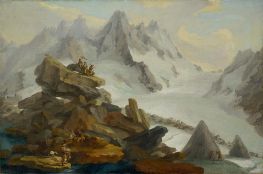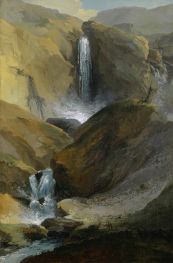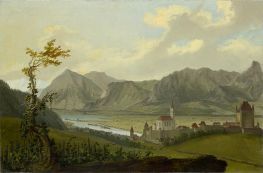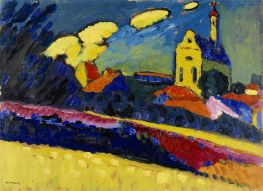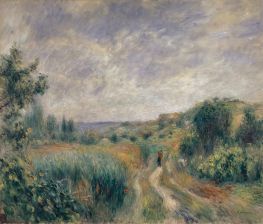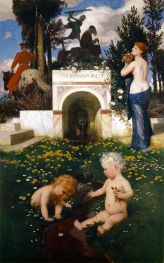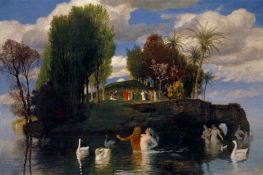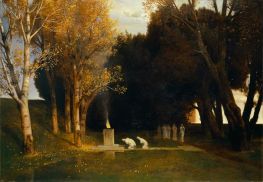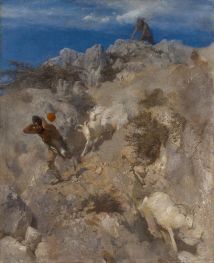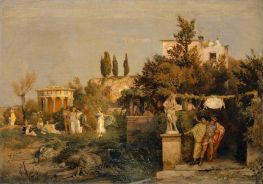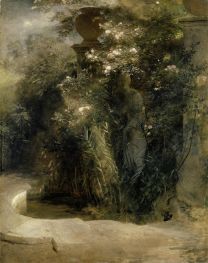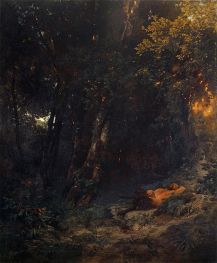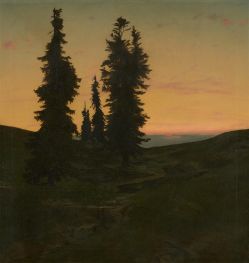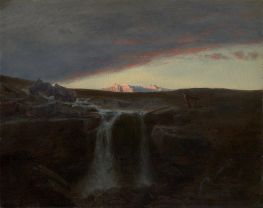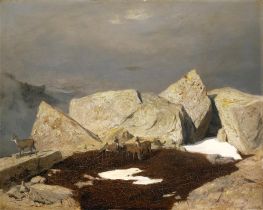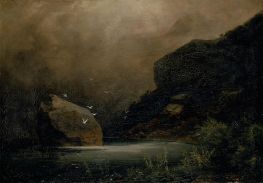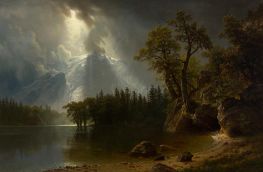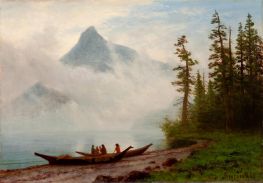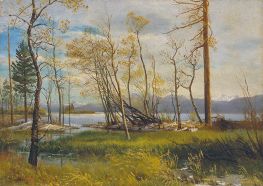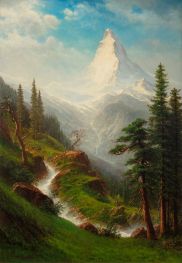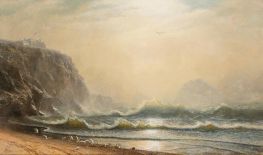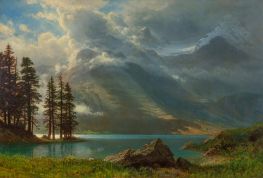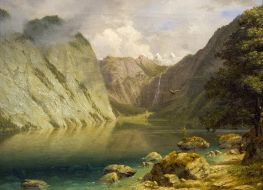Landscape Painting Reproductions - Page 10
Landscape painting is a genre of art that depicts outdoor scenes, such as mountains, forests, rivers, and gardens. The history of landscape painting dates back to ancient times, with examples from ancient Egyptian, Greek, and Roman art. During the Middle Ages, landscape paintings were mainly used as backgrounds for religious scenes, and it was not until the Renaissance that landscape painting emerged as a separate genre.
During the Renaissance, artists started to focus more on the natural world and began to experiment with perspective, light and shadow, and atmospheric effects in their landscapes. This period also saw the rise of topographical painting, which depicted accurate views of specific locations. During this time, artists such as Leonardo da Vinci and Albrecht Dürer produced iconic landscape paintings.
The 17th century Dutch Golden Age saw a trend towards landscapes that were more genre-like and less topographical, with scenes of everyday life and landscapes with rolling hills, waterways, and windmills. This period is also known for the development of the "Dutch light" style, which was characterized by a luminous, highly transparent quality of light and a preference for sunny skies. Painters such as Jan van Goyen and Jacob van Ruisdael became renowned for their realistic landscapes.
In the 18th and 19th centuries, Romanticism and the interest in the Sublime in art and literature led to a focus on dramatic, awe-inspiring landscapes. Painters such as J.M.W. Turner and Caspar David Friedrich used dramatic light, color, and form to evoke a sense of awe and drama in their landscapes.
The Impressionist movement of the late 19th century was characterized by its loose brushwork, light color palette, and emphasis on capturing the fleeting effects of light and atmosphere. Impressionist landscapes, such as those by Claude Monet and Pierre-Auguste Renoir, often depicted modern life, with leisurely scenes of parks, gardens, and the countryside.
Throughout the 20th century, landscape painting continued to evolve and diversify, with many artists pushing the boundaries of the genre through new styles and techniques. Some notable examples include the abstract landscapes of artists such as Mark Rothko and Joan Mitchell, and the photorealistic landscapes of Richard Estes and Ralph Goings.
Overall, landscape painting has a rich and varied history, reflecting the changing attitudes and perspectives of different cultures and time periods.
During the Renaissance, artists started to focus more on the natural world and began to experiment with perspective, light and shadow, and atmospheric effects in their landscapes. This period also saw the rise of topographical painting, which depicted accurate views of specific locations. During this time, artists such as Leonardo da Vinci and Albrecht Dürer produced iconic landscape paintings.
The 17th century Dutch Golden Age saw a trend towards landscapes that were more genre-like and less topographical, with scenes of everyday life and landscapes with rolling hills, waterways, and windmills. This period is also known for the development of the "Dutch light" style, which was characterized by a luminous, highly transparent quality of light and a preference for sunny skies. Painters such as Jan van Goyen and Jacob van Ruisdael became renowned for their realistic landscapes.
In the 18th and 19th centuries, Romanticism and the interest in the Sublime in art and literature led to a focus on dramatic, awe-inspiring landscapes. Painters such as J.M.W. Turner and Caspar David Friedrich used dramatic light, color, and form to evoke a sense of awe and drama in their landscapes.
The Impressionist movement of the late 19th century was characterized by its loose brushwork, light color palette, and emphasis on capturing the fleeting effects of light and atmosphere. Impressionist landscapes, such as those by Claude Monet and Pierre-Auguste Renoir, often depicted modern life, with leisurely scenes of parks, gardens, and the countryside.
Throughout the 20th century, landscape painting continued to evolve and diversify, with many artists pushing the boundaries of the genre through new styles and techniques. Some notable examples include the abstract landscapes of artists such as Mark Rothko and Joan Mitchell, and the photorealistic landscapes of Richard Estes and Ralph Goings.
Overall, landscape painting has a rich and varied history, reflecting the changing attitudes and perspectives of different cultures and time periods.
page 10 of 278
SKU: WOC-19348
Caspar Wolf
Original Size: 54.8 x 82.6 cm
Kunstmuseum Basel Switzerland
Caspar Wolf
Original Size: 54.8 x 82.6 cm
Kunstmuseum Basel Switzerland
The Gelten Fall in the Lauenen Valley in Summer 1777
Caspar Wolf
Oil Painting
$1062
$1062
Canvas Print
$56.57
$56.57
SKU: WOC-19347
Caspar Wolf
Original Size: 82 x 54 cm
Kunstmuseum Basel Switzerland
Caspar Wolf
Original Size: 82 x 54 cm
Kunstmuseum Basel Switzerland
SKU: WOC-19346
Caspar Wolf
Original Size: 54 x 82 cm
Kunstmuseum Basel Switzerland
Caspar Wolf
Original Size: 54 x 82 cm
Kunstmuseum Basel Switzerland
SKU: KAW-19342
Wassily Kandinsky
Original Size: 33 x 45 cm
Kunstmuseum Basel Switzerland
Wassily Kandinsky
Original Size: 33 x 45 cm
Kunstmuseum Basel Switzerland
SKU: RPA-19340
Pierre-Auguste Renoir
Original Size: 46.6 x 55.2 cm
Kunstmuseum Basel Switzerland
Pierre-Auguste Renoir
Original Size: 46.6 x 55.2 cm
Kunstmuseum Basel Switzerland
SKU: BOA-19338
Arnold Bocklin
Original Size: 180 x 114.5 cm
Kunstmuseum Basel Switzerland
Arnold Bocklin
Original Size: 180 x 114.5 cm
Kunstmuseum Basel Switzerland
SKU: BOA-19337
Arnold Bocklin
Original Size: 93.3 x 140 cm
Kunstmuseum Basel Switzerland
Arnold Bocklin
Original Size: 93.3 x 140 cm
Kunstmuseum Basel Switzerland
SKU: BOA-19335
Arnold Bocklin
Original Size: 105 x 150.6 cm
Kunstmuseum Basel Switzerland
Arnold Bocklin
Original Size: 105 x 150.6 cm
Kunstmuseum Basel Switzerland
Pan Frightening a Shepherd (Terrified Panic) 1859
Arnold Bocklin
Oil Painting
$986
$986
Canvas Print
$69.81
$69.81
SKU: BOA-19332
Arnold Bocklin
Original Size: 78 x 63.8 cm
Kunstmuseum Basel Switzerland
Arnold Bocklin
Original Size: 78 x 63.8 cm
Kunstmuseum Basel Switzerland
SKU: BOA-19331
Arnold Bocklin
Original Size: 44.2 x 62.4 cm
Kunstmuseum Basel Switzerland
Arnold Bocklin
Original Size: 44.2 x 62.4 cm
Kunstmuseum Basel Switzerland
SKU: BOA-19330
Arnold Bocklin
Original Size: 120 x 95 cm
Kunstmuseum Basel Switzerland
Arnold Bocklin
Original Size: 120 x 95 cm
Kunstmuseum Basel Switzerland
SKU: BOA-19329
Arnold Bocklin
Original Size: 89.8 x 75.2 cm
Kunstmuseum Basel Switzerland
Arnold Bocklin
Original Size: 89.8 x 75.2 cm
Kunstmuseum Basel Switzerland
SKU: BOA-19328
Arnold Bocklin
Original Size: 76.8 x 74.6 cm
Kunstmuseum Basel Switzerland
Arnold Bocklin
Original Size: 76.8 x 74.6 cm
Kunstmuseum Basel Switzerland
SKU: BOA-19327
Arnold Bocklin
Original Size: 32.8 x 40.8 cm
Kunstmuseum Basel Switzerland
Arnold Bocklin
Original Size: 32.8 x 40.8 cm
Kunstmuseum Basel Switzerland
SKU: BOA-19326
Arnold Bocklin
Original Size: 32.5 x 41 cm
Kunstmuseum Basel Switzerland
Arnold Bocklin
Original Size: 32.5 x 41 cm
Kunstmuseum Basel Switzerland
SKU: BOA-19325
Arnold Bocklin
Original Size: 45.6 x 64.7 cm
Kunstmuseum Basel Switzerland
Arnold Bocklin
Original Size: 45.6 x 64.7 cm
Kunstmuseum Basel Switzerland
SKU: BOA-19324
Arnold Bocklin
Original Size: 60.2 x 77.5 cm
Kunstmuseum Basel Switzerland
Arnold Bocklin
Original Size: 60.2 x 77.5 cm
Kunstmuseum Basel Switzerland
SKU: BAL-19323
Albert Bierstadt
Original Size: 92.7 x 139.7 cm
San Antonio Museum of Art Texas USA
Albert Bierstadt
Original Size: 92.7 x 139.7 cm
San Antonio Museum of Art Texas USA
SKU: BAL-19322
Albert Bierstadt
Original Size: 35.5 x 50.8 cm
Indianapolis Museum of Art Indiana USA
Albert Bierstadt
Original Size: 35.5 x 50.8 cm
Indianapolis Museum of Art Indiana USA
SKU: BAL-19321
Albert Bierstadt
Original Size: 34 x 48 cm
Amon Carter Museum Texas USA
Albert Bierstadt
Original Size: 34 x 48 cm
Amon Carter Museum Texas USA
SKU: BAL-19320
Albert Bierstadt
Original Size: 100.5 x 70 cm
Public Collection
Albert Bierstadt
Original Size: 100.5 x 70 cm
Public Collection
SKU: BAL-19319
Albert Bierstadt
Original Size: 44.2 x 75 cm
Public Collection
Albert Bierstadt
Original Size: 44.2 x 75 cm
Public Collection
SKU: BAL-19318
Albert Bierstadt
Original Size: 75 x 111 cm
Public Collection
Albert Bierstadt
Original Size: 75 x 111 cm
Public Collection
SKU: BAL-19317
Albert Bierstadt
Original Size: 20 x 26.4 cm
Spencer Museum of Art at the University of Kansas Lawrence USA
Albert Bierstadt
Original Size: 20 x 26.4 cm
Spencer Museum of Art at the University of Kansas Lawrence USA
